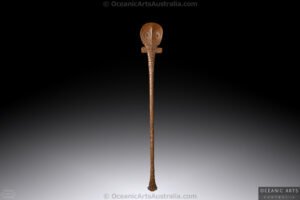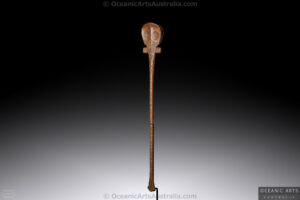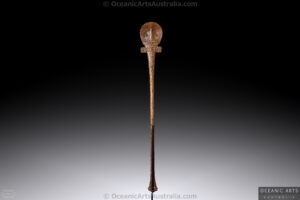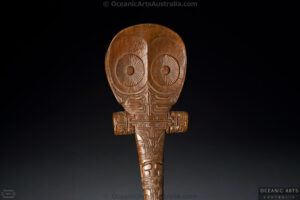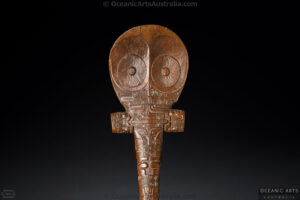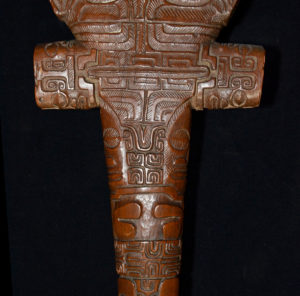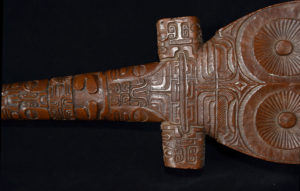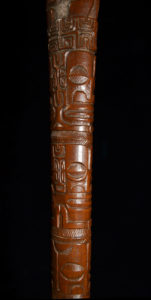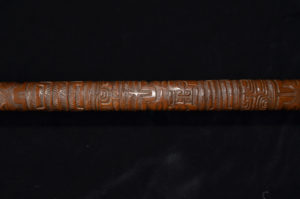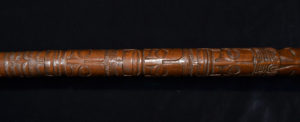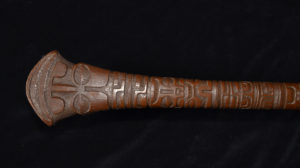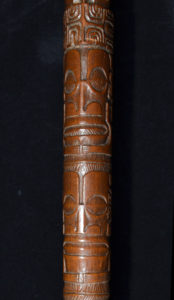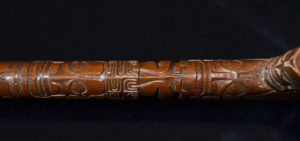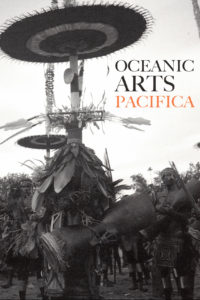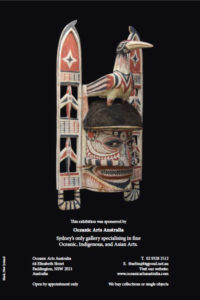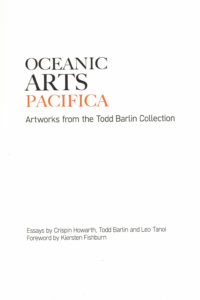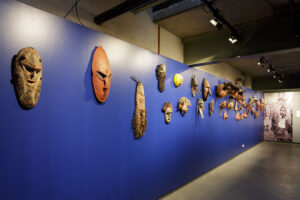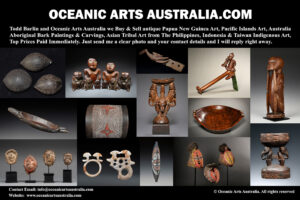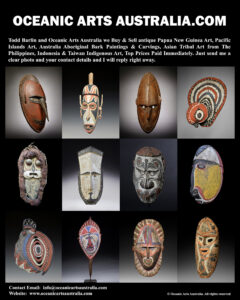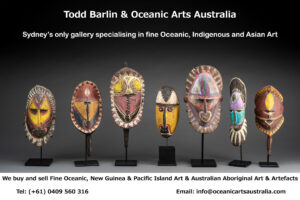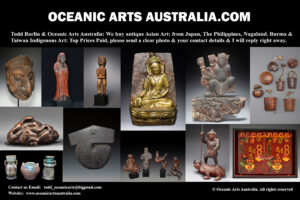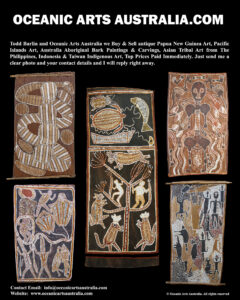A Superb Old Marquesas Islands U’u’ War Club French Polynesia 19th Century
| Collection No. | TB-2764 |
|---|---|
| Size | Height: 134.5 cm |
A Superb Old Marquesas Islands U’u’ War Club French Polynesia dating from the late 19th Century Circa 1880s
This superb old Club known as Uu is from the Marquesas Islands in French Polynesia in the central South Pacific Ocean. Carved from a single piece of heavy hardwood and then intricately carved by a master artist over the entire surface of the club.
The finely carved designs include 8 double pairs of back-to-back ancestor figures along the length of the handle ending in a stylized face at the club butt. The flared top of the club is a large face and just below the crossbar made of Two double figures on either side. The intricated designs are similar to the famous Marquesas tattoo designs on warriors’ bodies.
The carvings is so fine it’s hard to imagine the skill and effort that went into carving them over long months, the artist didn’t seem to make an error in his designs over the entire surface of this beautiful sculpture.
Provenance: The Todd Barlin Collection of New Guinea Oceanic & Polynesian Art
As described by Carol Ivory, ” Marquesas ‘u’u: A Stylistic and Historical Review, Pacific Arts No. 9-10 July 1994 ”
Warfare was an integral component of life in the Marquesas Islands in the late eighteenth and early nineteenth centuries, the result of territorial rivalries or the need to avenge insults and indignities. War was carried on either in pitched battles using clubs, spears, and slings, or in ambush situations. The pitched battles were usually pre-arranged and involved much ritual preparation and invocation to the etua, the gods, for success. The ambushes were usually forays into neighbouring valleys in search of heana, human victims for sacrifice. Leaders in warfare were high-ranking and influential persons in Marquesas society.
Clubs such as this one are called ‘U U “ and were a Marquesas warrior’s most prize possession. They served as both a weapon in close combat and as a mark of high status within society. They are made from ironwood (Casuarina equisetifolia), also called toa by the Marquesans, a dense, heavy, hardwood. The clubs were buried in the mud of taro fields, then polished with coconut oil, to give them a rich, dark patina. Strands of braided sennit, with human hair attached, were wrapped around the handle area. The hair was usually that of relatives. They were designed with a curved notch on the top edge so that the warrior could put it under his arm and lean on it. As a result, they vary in size, between 4.5 and 5 feet, depending on the height of the owner.
With rare exceptions, all ‘U U ” carved through the 1840s are so remarkably similar that they have been identified as a specific style: A/B by Karl von Steinen (1928) and A by me (Ivory 1994). Though no two ‘U U ” (nor the two sides of the same club) are exactly the same, their features are very consistent. The “head” of the club has two sides, each carved to resemble a large human face. Projecting knobs in the form of small heads suggest eyes and nose. A circle of striated lines surrounds each “eye”, similar to the Marquesan tattoo design called mata toetoe. Ridge-line curves between the eyes to form arching brows. Along the top is a beveled edge on which a small face is carved in low relief.
Below the high-relief eyes, a crossbar projects horizontally from the club. Another head, centrally placed on this crossbar, forms a “nose”. Immediately below are three zones of low relief carving consisting of two bands of designs between which is yet another set of eyes. The upper of these bands usually consists of two separated rectangular panels joined on the inner edges by thin arm-like lines. The lower band is continuous and generally filled with abstract geometric motifs, especially the ipu, another tattoo design…(in this case with two lizards)..The word ipu refers to containers of almost any kind, including cups, bowls, skulls, shells, and turtle shells, and can be understood as something hard that protects or shields. It was frequently tattooed on the inside of a warrior’s arms, a vulnerable spot, especially when raising the arm to attack by throwing or preparing to hit something.
The reason for all of the faces and eyes may have been to draw on the sacred power, and thus the protection of the ancestors, when in combat. Linguistics suggests that such repetition may indicate a symbolic relationship between the visual representation of the face or eye and an individual’s ancestry, as embodied by one’s genealogy. Mata is the Marquesan word for both face and eye, and also used to refer to genealogy. The term for the recitation of an individual’s genealogy, which established one’s place in the hierarchy of Marquesan society, is matatetau, literally to count or recite (tetau) faces/eyes (mata). Mata ‘enata (face/eye people) are one’s relatives, ancestors, or allies. Thus, there seem to be direct links between the notion of face and eyes and the ancestors, with their spiritual powers. The fact that there are two faces may have provided additional protection for the warrior, with eyes looking in two directions.
Such multiplication of faces, heads, and eyes is a form of visual “punning” with roots in the arts of the ancient Lapita Cultural Complex, whose peoples were the immediate ancestors of the Polynesians. Themselves most likely the descendants of indigenous Taiwanese, the Lapita peoples migrated across the Pacific from eastern New Guinea to Samoa, Tonga, and Fiji in little over 500 years, between 1000 and 500 BCE. Faces, repeated in patterns, are the single most important motif found on their distinctive decorated ceramic bowls.
The Marquesans were the most extensively (and most exquisitely) tattooed of all the Polynesian peoples. Nearly 500 named tattoo motifs are still known today, and their variations and meanings are complex. Specific motifs…(such as the lizard)…may have been indicated the owner of the clubs. “
References: Ivory, Carol. Marquesan ‘u’u: A Stylistic and Historical Review, Pacific Arts No. 9-10 July 1994: 53-63.
Ottino-Garanger, Pierre and Marie-Noëlle. Te Patu Tiki Le Tatouage aux îles Marquises, Tahiti: Pourcade, 1998.
Steinen, Karl von den. Die Marquesaner und Ihrer Kunst, vol II, Berlin: Dietrich Reimer, 1928.
ENQUIRE HERE
To see many more rare items and the finest masterpieces, please make an appointment with us to visit the gallery.
For all enquires, please contact us.

